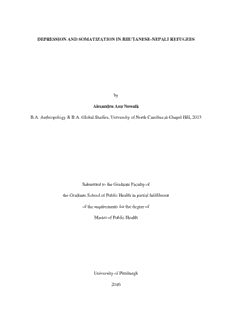
DEPRESSION AND SOMATIZATION IN BHUTANESE-NEPALI REFUGEES by Alexandra Ann ... PDF
Preview DEPRESSION AND SOMATIZATION IN BHUTANESE-NEPALI REFUGEES by Alexandra Ann ...
DEPRESSION AND SOMATIZATION IN BHUTANESE-NEPALI REFUGEES by Alexandra Ann Nowalk B.A. Anthropology & B.A. Global Studies, University of North Carolina at Chapel Hill, 2013 Submitted to the Graduate Faculty of the Graduate School of Public Health in partial fulfillment of the requirements for the degree of Master of Public Health University of Pittsburgh 2016 UNIVERSITY OF PITTSBURGH GRADUATE SCHOOL OF PUBLIC HEALTH This thesis was presented by Alexandra Ann Nowalk It was defended on April 12, 2016 and approved by Caroyln Ban, PhD, Professor, Graduate School of Public and International Affairs, University of Pittsburgh Joanne Russell, MPPM, Assistant Professor, Behavioral and Community Health Sciences, Graduate School of Public Health, University of Pittsburgh Thesis Director: Steven Albert, PhD, Professor and Chair, Behavioral and Community Health Sciences, Graduate School of Public Health, University of Pittsburgh ii Copyright © by Alexandra Nowalk 2016 iii Steven Albert, PhD DEPRESSION AND SOMATIZATION IN BHUTANESE-NEPALI REFUGEES Alexandra Nowalk, MPH University of Pittsburgh, 2016 ABSTRACT The number of Bhutanese-Nepali refugees entering Allegheny County has exceeded 4,500 over the last several years. Local physicians who work with this population have reported patients exhibiting symptoms of various mental disorders. This phenomenon is of grave concern, as various studies have found a suicide rate among Bhutanese-Nepali refugees that is significantly higher than the suicide rates for the general US population and other refugee groups. This research will determine if Bhutanese-Nepali cultural conceptualizations of mental health correlate to mental disorders classified in the Diagnostic Statistical Manual of Mental Disorders (DSM-V) through a series of individual interviews and a single focus group. By determining and improving the correlations between Bhutanese-Nepali culturally specific disease and western mental health diagnoses physicians will be able to provide informed, culturally- appropriate healthcare for refugees. As a result, public health practitioners will be able to better develop interventions that effectively address the mental health needs of Bhutanese-Nepali refugees and the quality of mental healthcare refugees receive will improve. iv TABLE OF CONTENTS 1.0 INTRODUCTION............................................................................................................. 1 2.0 BACKGROUND ............................................................................................................... 3 3.0 LITERATURE REVIEW ................................................................................................ 6 3.1 STAGES OF MIGRATION & MENTAL HEALTH RISK FACTORS ........ 6 3.1.1 Pre-Migration Stage ........................................................................................ 6 3.1.2 Migration Stage................................................................................................ 7 3.1.3 Post-Migration Stage ....................................................................................... 7 3.2 RISK FACTORS UNIQUE TO REFUGEES ................................................... 9 3.3 MENTAL HEALTH OUTCOMES IN MIGRANTS & REFUGEES .......... 10 3.3.1 Mental Health Outcomes in Migrants ......................................................... 10 3.3.2 Mental Health Outcomes in Refugees .......................................................... 11 3.4 CULTURAL AND POLITICAL HISTORY OF THE BHUTANESE- NEPALI ........................................................................................................................... 12 3.4.1 The Lhotshampas and Early Settlement of Bhutan ................................... 12 3.4.2 Political and Cultural Equality .................................................................... 13 3.4.2 Rise of Bhutanese Cultural Nationalism ..................................................... 14 3.4.4 Political Dissent and Conflict........................................................................ 17 3.4.5 Flight from Bhutan ........................................................................................ 19 v 3.5 MENTAL HEALTH IN BHUTANESE-NEPALI REFUGEES ................... 20 3.5.1 Prevalence of Mental Disorders ................................................................... 20 3.5.2 Depression in Bhutanese-Nepali Refugees .................................................. 21 3.5.3 Prevalence of Suicide & Associated Risk Factors ....................................... 27 3.5.4 Risk Factors for Mental Disorders ............................................................... 28 3.6 CLASSIFICATION OF MENTAL DISORDERS IN THE DSM-V ............ 29 3.6.1 Depressive Disorders ..................................................................................... 29 3.6.2 Somatic Symptom and Related Disorders ................................................... 30 3.7 IDIOMS OF DISTRESS ................................................................................... 31 4.0 MATERIALS AND METHODS ................................................................................... 33 4.1 STUDY DESIGN ............................................................................................... 33 4.2 PARTICIPANTS ............................................................................................... 34 4.2.1 Interviews ....................................................................................................... 34 4.2.1.1 Eligibility .............................................................................................. 34 4.2.1.2 Recruitment ......................................................................................... 35 4.2.2 Focus Groups ................................................................................................. 36 4.2.2.1 Eligibility .............................................................................................. 36 4.2.2.2 Recruitment ......................................................................................... 36 4.3 INSTRUMENTS ................................................................................................ 37 4.3.1 Interviews ....................................................................................................... 37 4.3.1.1 Patient Health Questionnaires ........................................................... 37 4.3.1.2 Cultural Formulation Interviews ...................................................... 38 4.3.2 Focus Group ................................................................................................... 39 vi 4.4 DATA COLLECTION ...................................................................................... 39 4.4.1 Interviews ....................................................................................................... 39 4.4.2 Focus Group ................................................................................................... 40 4.5 DATA ANALYSIS ............................................................................................. 41 5.0 RESULTS ........................................................................................................................ 43 5.1 INTERVIEWS ................................................................................................... 43 5.1.1 Patient Demographics ................................................................................... 43 5.1.2 Personal Health Questionnaires ................................................................... 44 5.1.2.1 Prevalence of Somatic Symptoms ...................................................... 44 5.1.2.2 Prevalence of Depressive Symptoms ................................................. 46 5.2 FOCUS GROUP ................................................................................................ 48 5.2.1 Focus Group Demographics ......................................................................... 48 5.2.2 Common Themes ........................................................................................... 48 5.2.2.1 Manifestation of Depression ............................................................... 48 5.2.2.2 Causes of Depression .......................................................................... 50 5.2.2.3 Effects of Depression on Daily Life ................................................... 51 5.2.2.4 Experiences with Healthcare in the United States ........................... 52 5.2.2.5 Mental Health in Nepal....................................................................... 53 5.2.2.6 Treatment for Depression .................................................................. 55 5.2.2.7 The Refugee Experience ..................................................................... 57 6.0 DISCUSSION .................................................................................................................. 58 6.1 ROLE OF MIND BODY DIVISIONS ............................................................. 59 6.2 ROLE OF IDIOMS OF DISTRESS ................................................................ 60 vii 6.3 IMPLICATIONS OR MENTAL HEALTH PROFESSIONALS ................. 61 6.4 LIMITATIONS .................................................................................................. 65 7.0 FUTURE DIRECTIONS ................................................................................................ 66 APPENDIX A :IRB APPROVAL.............................................................................................. 67 APPENDIX B : RECRUITMENT LETTER........................................................................... 70 APPENDIX C : INFORMED CONSENT................................................................................ 74 APPENDIX D : SOMATIC SYMPTOMS (PHQ-15).............................................................. 81 APPENDIX E: DEPRESSIVE SYMPTOMS (PHQ-9)........................................................... 83 APPENDIX F: FOCUS GROUP GUIDE... ............................................................................. 85 BIBLIOGRAPHY ....................................................................................................................... 88 viii LIST OF TABLES Table 1 - Raw Scores for Somatic Symptoms (PHQ-15) ............................................................. 45 Table 2 - Raw Scores for Depressive Symptoms (PHQ-9) .......................................................... 47 ix LIST OF FIGURES Figure 1 - Nepali Mind-Body Divisions & Treatment-Seeking Behavior .................................... 26 Figure 2 - Components of Nepali Ethnopsychology in Therapy Modalities ................................ 64 x
Description: